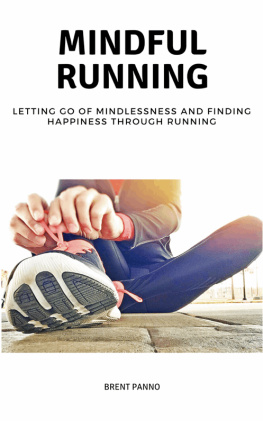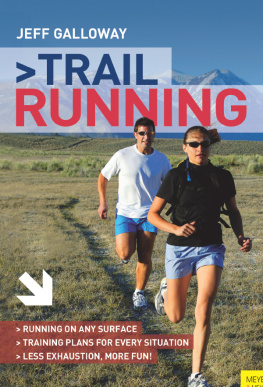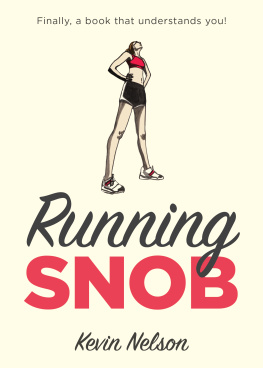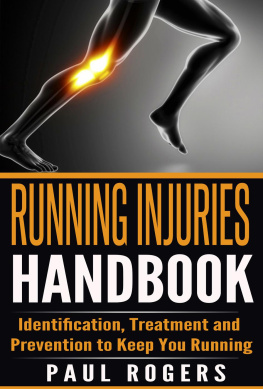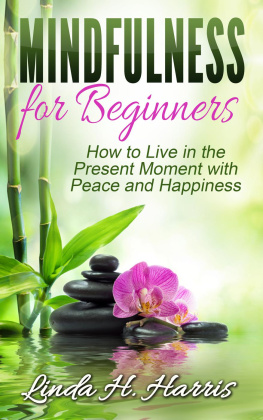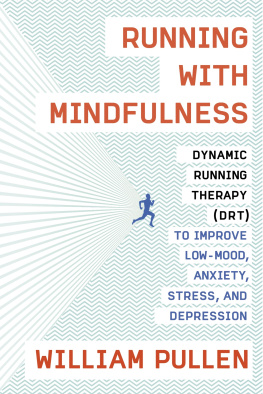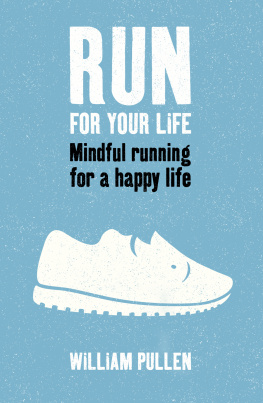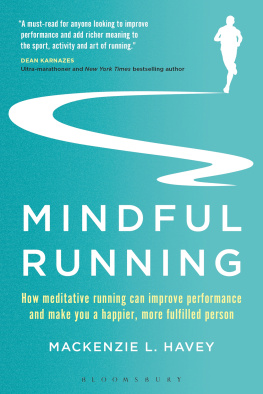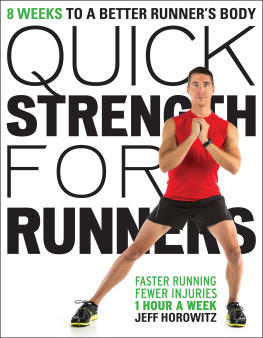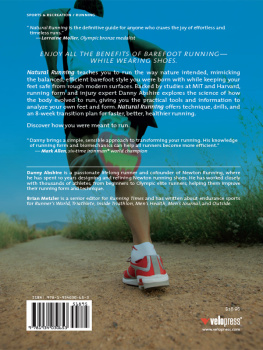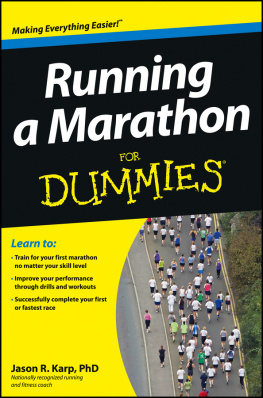Ch. 1 Introduction
What is Mindful Running?
I was drenched from head to toe, and my body felt like it wanted to quit. The rain had been pouring down all morning, with no sign of letting up. I was at mile 16 of my first marathon, the Illinois Marathon in Champaign, IL. My body was telling me to start walking, more like screaming it at me. My legs hurt, I was soaked, but through all of this, I was actually enjoying every second of my first marathon! Besides, if I stopped to walk for a little while, Im not sure I would have been able to start running again. There were a number of people running beside to me, and we got to experience this together, which made me feel a little better.
I got my second wind around mile 20, and I was able to finish the last several miles feeling pretty good. The race finished on the local Universitys football field, with a smattering of bold spectators who braved the rain. Most of the spectators were gathered inside the arena, taking shelter from the rain and cold. I slowly made my way inside to feast on pizza and pretzels that were given to the racers. Finishing my first marathon felt so good mentally, but not so great physically, as I hobbled back to my car with my wife. I felt better after a couple of days, and I was already planning on when my next marathon would be. Currently I have just started training for the Chicago Marathon in October, and I am very excited to be a part of their 40 th year anniversary. And after this race, if Im feeling well, I am considering running a 50k (31 miles) 3 weeks later.
So why should we do mindful running? Mindfulness is working its way into popular culture now, but the idea has been around for a long time. In todays world, there are constant distractions from our computer, phone, and television; it is difficult to be mindful at times, and puts us in a state of mindlessness. But, it is very necessary to learn how to become more aware of the present moment and to have less stress in order to find happiness. There are many methods to be mindful, and I will review some of them in later chapters. One that I enjoy greatly is being mindful while running. I enjoy doing sitting meditation as well, but I dont always have time in a busy day for this. So, I use mindfulness when I run to help to cultivate happiness. I started practicing meditation about 10 years ago. This helped me immensely with learning about myself, lowering my depression, and starting a path to living life in the moment. Around the same time I started running in races as well. At first it was just to stay in better shape for other sports, but it soon became one of the main sources of exercise and meditation for me.
When we are young, running comes as second nature, we are just playing with our friends. As we get older, some of us lose that feeling of joy when we are being active. This happened to me, where running felt more like a punishment. I was competing in other sports, and my coaches would have us run for our endurance and as a form of punishment. It was a means to an end, to get in shape to be able to do something else. For me, it was to be able to play tennis or compete in kickboxing; but as I began to run more, I started to find that running was not only a means to an end, but a way to be present, and to find happiness in my life.
Many of us have a baseline of happiness. When good things in our life happen, like getting an A on a paper, we have an increase in happiness. But this will soon lower back to our baseline. And the same goes for when we have bad things in our life happen. My baseline for happiness used to be fairly low; it was hard for me to stay happy for long periods of time without falling back into a slump. But, over time, and with a lot of learning about how to increase happiness, I was able to raise my baseline up. Now, I have a general feeling of being happy at most times. This will go up and down depending what happens to me day to day, but overall I enjoy my life greatly.
Running to me is now is a life long journey, and not a means to an end. I enjoy the process and the benefits of being healthy and in shape. But, these are not my end goals. Being able to run most of my life and enjoy it is one of my long term goals. I enjoy running races as well. My goal is not to win them, which would be nice, but to experience them in the moment and feel the rush of life. In one of my first races, a 5k, it was winter time. The race was exciting, with a good number of runners present. But, it was so cold, that after the race I was eating some refreshments and almost bit my tongue off. Nevertheless, I enjoyed almost every moment of the race (except for the biting my tongue part of course). I entered more 5k races, and eventually moved up to running half marathons, trail runs and marathons. The trail runs can be so beautiful, running up and down hills lined with trees. But it is good to pay close attention to the ground under you, as I have sprained my ankle on a few occasions tripping over tree roots. This is where mindfulness would have helped!
The races can be painful at times, but finishing a hard race is one of the best feelings I have felt. Being in these situations with other runners is great for boosting my mood as well. I have found that happiness does not come from avoiding hardships or discomfort. These seem to be needed to become happy. If you have ever gone on a long hike or camping trip, you might notice that a shower afterwards is way better than any shower you have previously had. So, avoiding discomfort is not a recipe for happiness, but rather the opposite. Without discomfort, it is much more difficult to know what happiness is. Some discomfort can be very difficult to deal with, such as stress from a job, family life, etc. And I will review ways to help with this in later chapters.
Mindfulness Meditation: The Nuts and Bolts
Lets get into what mindfulness means now. Mindfulness meditation is a process of being aware of what is happening in the present moment. Mindfulness has been used to help treat anxiety, stress, pain, and depression. It has its roots in Buddhist practices, where it is considered a basis for many of the teachings. The aim of mindfulness meditation is to be purposefully present in the moment and non-judgmental about the moment. The practitioner will accomplish this by focusing on an object such as the breath or body sensations for some amount of time, while paying attention to external and internal stimuli. Participants in mindfulness meditation use this practice to become aware of thought, feelings, and strong emotions, and to not become wrapped up in their content. This way the practitioner can realize what emotions are there, regard their feelings as passing events, and avoid reacting habitually to these emotions and thoughts. The meditator can then have a more flexible understanding of themselves and a more flexible use of their mind. At some point, the person may realize that they do not have to react to every passing emotion. This helps create a sense of calmness, and an understanding that you can handle almost any stressful situation while remaining in a positive or calm state of mind.
The use of mindfulness meditation for people with depression, anxiety or stress can help them to view negative thoughts non-judgmentally and without getting caught up in these thoughts. Mindfulness meditation can help the practitioner become aware of negative and repetitive patterns early on, and view them non-judgmentally so that the practitioner can choose among various options rather than mentally spiraling downwards. So people with depression, anxiety or stress can use mindfulness to avoid episodes of depression, create a more fluid and flexible environment, and increase constructive and positive thoughts.

